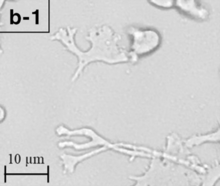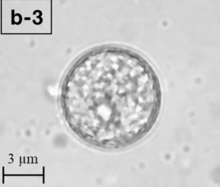This article needs additional citations for verification. (April 2021) |
| Balamuthia mandrillaris | |
|---|---|

| |
| Trophozoite (active) form of Balamuthia mandrillaris | |

| |
| A Balamuthia mandrillaris cyst | |
| Scientific classification | |
| Domain: | Eukaryota |
| Phylum: | Amoebozoa |
| Class: | Discosea |
| Order: | Centramoebida |
| Family: | Balamuthiidae |
| Genus: | Balamuthia Visvesvara et al., 1993 |
| Species: | B. mandrillaris
|
| Binomial name | |
| Balamuthia mandrillaris Visvesvara et al., 1993
| |
Balamuthia mandrillaris is a free-living amoeba that causes the rare but deadly neurological condition granulomatous amoebic encephalitis (GAE).[1] B. mandrillaris is a soil-dwelling amoeba and was first discovered in 1986 in the brain of a mandrill that died in the San Diego Wild Animal Park.[2][3]
B. mandrillaris can infect the body through open wounds or possibly by inhalation.[4] Balamuthia has been isolated from soil.[5][6] It is believed to be distributed throughout the temperate regions of the world. This is supported somewhat by the detection of antibodies to the protist in healthy individuals.
The generic name Balamuthia was given by Govinda Visvesvara, after his mentor, parasitologist William Balamuth, for his contributions to the study of amoebae. Visvesvara isolated and studied the pathogen for the first time in 1993.[7]
- ^ Sarica, Feyzi Birol; Tufan, Kadir; Cekinmez, Melih; Erdoğan, Bülent; Altinörs, Mehmet Nur (2009). "A rare but fatal case of granulomatous amebic encephalitis with brain abscess: the first case reported from Turkey". Turkish Neurosurgery. 19 (3): 256–259. PMID 19621290.
- ^ Cope, Jennifer R.; Landa, Janet; Nethercut, Hannah; Collier, Sarah A.; Glaser, Carol; Moser, Melanie; Puttagunta, Raghuveer; Yoder, Jonathan S.; Ali, Ibne K.; Roy, Sharon L. (2019-05-17). "The Epidemiology and Clinical Features of Balamuthia mandrillaris Disease in the United States, 1974 – 2016". Clinical Infectious Diseases. 68 (11): 1815–1822. doi:10.1093/cid/ciy813. ISSN 1058-4838. PMC 7453664. PMID 30239654.
- ^ Visvesvara, G S; Martinez, A J; Schuster, F L; Leitch, G J; Wallace, S V; Sawyer, T K; Anderson, M (1990-12-28). "Leptomyxid ameba, a new agent of amebic meningoencephalitis in humans and animals". Journal of Clinical Microbiology. 28 (12): 2750–2756. doi:10.1128/jcm.28.12.2750-2756.1990. ISSN 0095-1137. PMC 268267. PMID 2280005.
- ^ "Balamuthia mandrillaris ameba infection". Centers for Disease Control and Prevention. Retrieved 14 June 2014.
- ^ Frederick L. Schuster; Thelma H. Dunnebacke; Gregory C. Booton; Shigeo Yagi; Candice K. Kohlmeier; Carol Glaser; Duc Vugia; Anna Bakardjiev; Parvin Azimi; Mary Maddux-Gonzalez; A. Julio Martinez; Govinda S. Visvesvara (July 2003). "Environmental Isolation of Balamuthia mandrillaris Associated with a Case of Amebic Encephalitis". J. Clin. Microbiol. 41 (7): 3175–3180. doi:10.1128/JCM.41.7.3175-3180.2003. PMC 165348. PMID 12843060.
- ^ Thelma H. Dunnebacke; Frederick L. Schuster; Shigeo Yagi; Gregory C. Booton (September 2004). "Balamuthia mandrillaris from soil samples". Microbiology. 150 (Pt 9): 2837–2842. doi:10.1099/mic.0.27218-0. PMID 15347743. Archived from the original (PDF) on 2018-07-27. Retrieved 2017-06-20.
- ^ Kaneshiro, E. S.; Marciano-Cabral, F.; Moura, H. (2014). "Govinda S. Visvesvara: A Tribute". The Journal of Eukaryotic Microbiology. 62 (1): 1–2. doi:10.1111/jeu.12143. PMC 5674982. PMID 25040661.